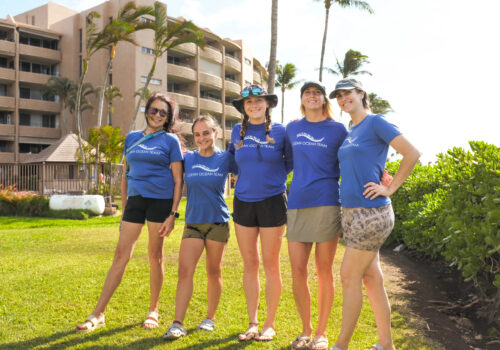Clean ocean water is essential for healthy coral reefs. It’s also important to residents and visitors who enjoy swimming, snorkeling, diving, paddling, fishing and surfing along Maui’s coasts.
Maui Nui Marine Resource Council is proud to be a major partner in an innovative community-based water quality monitoring program called Hui O Ka Wai Ola (Association of Living Waters).
Filling an important need
Hui O Ka Wai Ola is a wonderful example of how nonprofit organizations can effectively work with government agencies to expand the agency’s resources and capabilities.
Maui Nui Marine Resource Council, The Nature Conservancy and West Maui Ridge to Reef Initiative co-founded and co-manage Hui O Ka Wai Ola to support the State of Hawaiʻi Department of Health Clean Water Branch.
Together with the help of volunteers from the community, Hui O Ka Wai Ola has greatly expanded the Department of Health’s ability to test ocean water quality at Maui beaches and to provide quality-assured data to County, State and Federal agencies.
We add to the data collected by the Department of Health with our testing that keeps a close eye on changing water quality conditions that can harm our coral reefs.
Our community-based program regularly gathers data about sediment, nutrients in the water, temperature, pH and more along Maui’s south and west shores.
Hui O Ka Wai Ola currently monitors water quality at 41 sites. This number can change periodically as sites may be “paused” or discontinued for one or more of the following reasons: we have a good understanding of their water quality dynamics, these sites have little to no pollution or fluctuation, no management is currently underway for contributing land-based pollution, and/or no permanent funding is available to continue monitoring these sites.
Where We Test
WEST MAUI SITES 2025
Honolua Bay
Oneola Beach
Kapalua Bay
Nāpili Bay
Kāʻopala Bay
Kahana Village
Pōhaku Park
Kā’anapali Shores
Kahekili Two
Hanaka’ō’ō Park (Canoe Beach)
Wahikuli Park
Māla Tavern
Pāpalaua St
Lāhainā Harbor
505 Front St
Kauaʻula Rd
Polanui-ʻŪhāʻīlio
Camp Olowalu
Mile Marker 14
Ukumehame Park
Pāpalaua Pali
SOUTH MAUI SITES 2025
Māʻalaea Harbor
Māʻalaea Condos
Haycraft Park
Keālia Pond
Sugar Beach
Kīhei Canoe Club
Mai Poina Park
Kalepolepo Park North
Waipuʻilani Park
West Līpoa St
Kalama Park
Cove Park
Kilohana Dr
Keawakapu Beach South
Ulua Park
Palauʻea Beach
Maluaka Beach
‘Āhihi-Kīna’u North
’Āhihi-Kīna’u South
What We Test For
Turbidity
How it is measured: We gather samples at knee depth, then use a turbidity meter onsite to measure the amount of sediment (turbidity) in the water.
How changes are caused: Sediment carried from the land to the ocean (by streams, flooding, storm runoff) can cause ocean water to become brown or murky.
Why it is a concern: Sediment blocks sunlight from reaching reefs and can smother corals.
What we can do: When we find areas with high levels of turbidity, we can address upslope issues such as grading or clearing of land that caused sediment to flow into the ocean.
Ocean chemistry
How it is measured: We measure pH, salinity and water temperature onsite using portable, handheld equipment.
How changes are caused: Changes in ocean chemistry can be caused by climate change and other local factors. Salinity can be changed by freshwater flowing into the ocean. Water temperature can fluctuate by season and can also be caused by climate change. Ocean acidity can be increased warming ocean temperatures. Warmer water also holds less dissolved oxygen (needed for aquatic plants and animals to survive).
Why it is a concern: Corals are very sensitive to changes in ocean chemistry, including increased ocean water acidity. Corals bleach when water temperature increases; collecting water temperature can help track localized variations between sites.
What we can do: We can monitor changes in reef health against changes in ocean water quality and continue to advocate for ways to reduce greenhouse gases and reverse climate change.
Nutrients (nitrogen and phosphorous)
How they are measured: Water samples are gathered, refrigerated and shipped on ice to the SOEST Analytical Laboratory on Oahu for analysis of nitrogen and phosphorous.
How changes are caused: High levels of nitrogen and phosphorous can indicate pollution from wastewater, run-off from agriculture, landscaping and/or golf courses.
Why it is a concern: Too much nitrogen can cause an increase in invasive algae (limu), which is damaging to coral reefs.
What we can do: When we identify ocean areas with high levels of nutrients, we can pinpoint and address up-slope areas that are sources.
Our partners
Hui O Ka Wai Ola works closely with the State of Hawaii Department of Health (DOH). The program is managed by these nonprofit partners:
- Maui Nui Marine Resource Council (MNMRC)
- The Nature Conservancy (TNC)
- West Maui Ridge to Reef (R2R) Initiative












